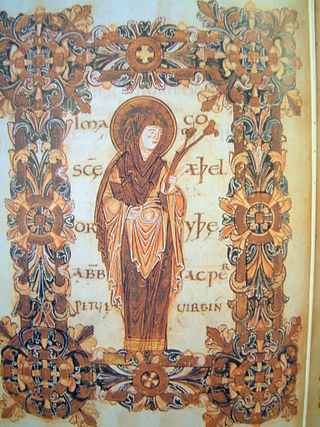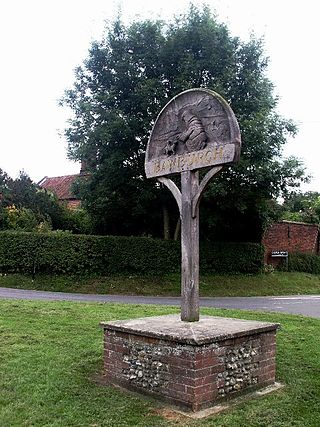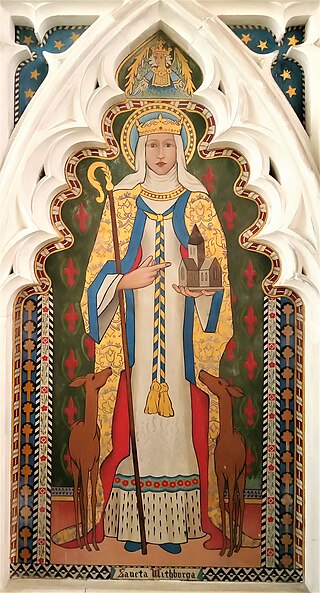
St Benet's Abbey, also known as St Benet's at Holme or St Benet Hulme, was a medieval monastery of the Order of Saint Benedict situated at Cow Holm in Horning, Norfolk, England. It lay on the River Bure within the Broads. St Benet is a medieval English version of the name of St Benedict of Nursia, hailed as the founder of western monasticism. At the period of the Dissolution of the Monasteries the abbey's possessions were in effect seized by the crown and assigned to the diocese of Norwich. Though the monastery was supposed to continue as a community, within a few years at least the monks had dispersed. Today there remain only ruins.

Edmund the Martyr was king of East Anglia from about 855 until his death.

Æthelthryth was an East Anglian princess, a Fenland and Northumbrian queen and Abbess of Ely. She is an Anglo-Saxon saint, and is also known as Etheldreda or Audrey, especially in religious contexts. She was a daughter of Anna, King of East Anglia, and her siblings were Wendreda and Seaxburh of Ely, both of whom eventually retired from secular life and founded abbeys.

Eadburh of Bicester was an English nun, abbess, and saint from the 7th century. She has been called a "bit of a mystery"; there have been several Saxon saints with the same name, so it is difficult to pinpoint which one was Eadburh. It is most likely that Eadburh of Bicester was the daughter of King Penda of Mercia, who was pagan but had several children who were Christians. Eadburgh was born in the now-deserted village of Quarrendon in Buckinghamshire. Her sister was Edith, with whom she co-founded an abbey near Aylesburg; Eadburh probably became abbess at Aylesburg. She was also aunt of Osgyth, whom she trained "in the religious life". There are legends that claim that Edburgh and Edith found Osyth after she had drowned three days earlier and "witnessed her return to life".
Honorius was a member of the Gregorian mission to Christianize the Anglo-Saxons from their native Anglo-Saxon paganism in 597 AD who later became Archbishop of Canterbury. During his archiepiscopate, he consecrated the first native English bishop of Rochester as well as helping the missionary efforts of Felix among the East Anglians. Honorius was the last to die among the Gregorian missionaries.
Holkham is a small village and civil parish in north Norfolk, England, which includes a stately home and estate, Holkham Hall, and a beach, Holkham Gap, at the centre of Holkham National Nature Reserve.

Costessey is a town and civil parish in the South Norfolk district of Norfolk, England, and is 4 miles (6.4 km) north west of Norwich. The civil parish forms part of the Norwich Urban Area.

Ælfwald was an 8th-century king of East Anglia, an Anglo-Saxon kingdom that today includes the English counties of Norfolk and Suffolk. The last king of the Wuffingas dynasty, Ælfwald succeeded his father Ealdwulf, who had ruled for 49 years. Ælfwald himself ruled for 36 years. Their combined reigns, with barely any record of external military action or internal dynastic strife, represent a long period of peaceful stability for the East Angles. In Ælfwald's time, this was probably owing to a number of factors, including the settled nature of East Anglian ecclesiastical affairs and the prosperity brought through Rhineland commerce with the East Anglian port of Gipeswic. The coinage of Anglo-Saxon sceattas expanded in Ælfwald's time: evidence of East Anglian mints, markets, and industry are suggested where concentrations of such coins have been discovered.

Walston was an Anglo-Saxon prince, known for the miracles which occurred during and after his life after he became a farm worker. He is a patron saint of farm animals and agricultural workers, who once visited his shrine at the church at Bawburgh, in the English county of Norfolk. Two sources for his life exist: the De Sancto Walstano Confessore in the Nova Legenda Angliæ, printed by Wynkyn de Worde in 1516, and known as the English Life; and a later Latin manuscript copied in 1658 from a now lost medieval triptych, now in the Lambeth Palace library in London.

Bawburgh is a village and civil parish in the South Norfolk district of Norfolk, England, lying in the valley of the River Yare about 5 miles (8.0 km) west of Norwich city centre. According to the 2001 census it had a population of 466, increasing to 595 at the 2011 census. Bawburgh is very close to the relatively new Norfolk and Norwich University Hospital and the Bowthorpe Estate.

Æthelberht, also called Saint Ethelbert the King was an 8th-century saint and a king of East Anglia, the Anglo-Saxon kingdom which today includes the English counties of Norfolk and Suffolk. Little is known of his reign, which may have begun in 779, according to later sources, and very few of the coins he issued have been discovered. It is known from the Anglo-Saxon Chronicle that he was killed on the orders of Offa of Mercia in 794.

Wihtburh was an East Anglian saint, princess and abbess. According to tradition, she was the youngest daughter of Anna, king of the East Angles, but Virginia Blanton has suggested that the royal connection was probably a fabrication. One story says that the Virgin Mary sent a pair of female deer to provide milk for Wihtburh's workers during the construction of her convent at Dereham, in Norfolk. When a local official attempted to hunt down the does, he was thrown from his horse and killed.

Felix of Burgundy, also known as Felix of Dunwich, was the first bishop of the kingdom of the East Angles. He is widely credited as the man who introduced Christianity to the kingdom. Almost all that is known about him comes from the Ecclesiastical History of the English People, completed by the English historian Bede in about 731, and the Anglo-Saxon Chronicle. Bede wrote that Felix freed "the whole of this kingdom from long-standing evil and unhappiness".

Ilketshall St Andrew is a village and civil parish in the north of the English county of Suffolk. It is 3 miles (4.8 km) south-east of Bungay and the same distance south-west of Beccles in the East Suffolk district. St Andrew's church is one of around 40 round-tower churches in Suffolk.

St Julian's is a Grade I listed parish church in the Church of England in Norwich, England. It is part of the Diocese of Norwich. During the Middle Ages, when the city was prosperous and possibly the second largest city in medieval England, the anchoress Julian of Norwich lived in a cell attached to the church. The cell was demolished during the 1530s.

In architecture, flushwork is decorative masonry work which combines on the same flat plane flint and ashlar stone. If the stone projects from a flat flint wall then the term is proudwork, as the stone stands "proud" rather than being "flush" with the wall.

Richard Makilwaine Phipson (1827–1884) was an English architect. As diocesan architect for the Anglican Diocese of Norwich, he was responsible for renovating almost 100 churches in East Anglia.

Jurmin also known as Hiurmine of Blythburgh, was an Anglo-Saxon prince who was the son and heir of Anna of East Anglia, a 7th-century king of East Anglia, a kingdom which today includes the English counties of Norfolk and Suffolk. As such, he was the brother of saints Seaxburh of Ely, Æthelthryth, and Æthelburh of Faremoutiers.

The Ranworth rood screen at Church of St Helen, Ranworth, Norfolk, is a wooden medieval rood screen that divides the chancel and nave, and was originally designed to act to separate the laity from the clergy. It is described by English Heritage as "one of England's finest painted screens".
John Heydon of Baconsthorpe, Norfolk, was of humble origins, the son of a yeoman, William Baxter of Heydon. He became a successful lawyer, and is known, through the Paston Letters, as one of the principal agents in East Anglia of William de la Pole, 1st Duke of Suffolk, and one of the chief opponents of the Paston family.

















